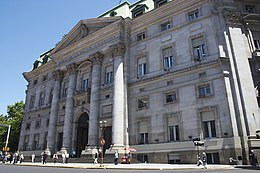Argentine economy

|
|
| Currency | Argentine peso (ARS) |
|---|---|
| Calendar year | |
|
Trade organizations
|
WTO, Mercosur, Unasur |
| Statistics | |
| GDP | $630.4 billion (nominal) (21st, 2015) $884.2 billion (PPP) (26th, 2015) |
|
GDP growth
|
-2.6% (2014), 2.5% (2015), -2.3% (2016e), 2.7% (2017f) |
|
GDP per capita
|
$14,617 (nominal) (53rd, 2015) $20,499 (PPP) (63rd, 2015) |
|
GDP by sector
|
Agriculture, forestry, and fishing, 6.0% mining, 3.6% manufacturing, 17.2% construction, 5.6% commerce and tourism, 16.9% transport, communications, and utilities, 7.9% government, 9.5% business, social and other services, 33.3%. (2015) |
| 39.1% (August 2016) | |
|
Population below poverty line
|
32.2% (2016) Official (INDEC) figure; alternative 2013 estimates vary from 15.4% (CONICET), to 27.5% (UCA), and 28.9% (CGT). |
| 0.427 (2014) | |
|
Labor force
|
17.9 million (2012) Categories: private sector employees, 49% employers and the self-employed, 27% public-sector employees, 21% unpaid family workers, 3% (2001). |
|
Labor force by occupation
|
Agricultural, 7.3% manufacturing, 13.1% construction, 7.6% commerce and tourism, 21.4% transport, communications and utilities, 7.8% financial, real estate and business services, 9.4% public administration and defense, 6.3% social services and other, 27.1%. (2006) |
| Unemployment | 8.5% (September 2016) |
|
Average gross salary
|
AR$ 18,367 monthly (June 2016) |
|
Main industries
|
Food processing and beverages; motor vehicles and auto parts; appliances and electronics; chemicals, petrochemicals, and biodiesel; pharmaceuticals; steel and aluminum; machinery; glass and cement; textiles; tobacco products; publishing; furniture; leather. |
| 116th (2017) | |
| External | |
| Exports | $56.76 billion (2015) |
|
Export goods
|
Soybeans and derivatives, petroleum and gas, vehicles, corn, wheat |
|
Main export partners
|
|
| Imports | $57.18 billion (2015) |
|
Import goods
|
Machinery, motor vehicles, petroleum and natural gas, organic chemicals, plastics |
|
Main import partners
|
|
|
FDI stock
|
$94.19 billion (2015) |
|
Gross external debt
|
$163.2 billion; of which public, $92.5 billion (March 2016) |
| Public finances | |
| $222.7 billion (bonds, 68%); 44.8% of GDP (December 2015) | |
| Revenues | $142.9 billion (2015) (social security, 25.9%; income and capital gains, 23.6%; value-added sales tax, 20.1%; trade and duties, 15.1%; financial tax, 6.3%; excise and other, 9.0%) |
| Expenses | $167.3 billion (2015) (social security, 38.8%; subsidies and infrastructure, 22.5%; debt service, 9.2%; education, culture and research, 8.8%; social assistance, 5.4%; health, 3.4%; security, 3.1%; defense, 2.1%; other, 6.7%) |
| B- (Domestic) SD (Foreign) B- (T&C Assessment) (Standard & Poor's) |
|
|
Foreign reserves
|
$39.9 billion (January 2017) |
The economy of Argentina is a high-income economy, Latin America's third largest, and the second largest in South America behind Brazil.
The country benefits from rich natural resources, a highly literate population, an export-oriented agricultural sector, and a diversified industrial base. Argentina's economic performance has historically been very uneven, in which high economic growth alternated with severe recessions, particularly during the late twentieth century, and income maldistribution and poverty increased. Early in the twentieth century Argentina had one of the highest per capita GDP levels in the world and the third largest economy in the developing world. Today a high-income economy, Argentina maintains a relatively high quality of life and GDP per capita.
Argentina is considered an emerging market by the FTSE Global Equity Index, and is one of the G-20 major economies.
Prior to the 1880s, Argentina was a relatively isolated backwater, dependent on the salted meat, wool, leather, and hide industries for both the greater part of its foreign exchange and the generation of domestic income and profits. The Argentine economy began to experience swift growth after 1880 through the export of livestock and grain commodities, as well as through British and French investment, marking the beginning of a fifty-year era of significant economic expansion and mass European immigration.
...
Wikipedia
